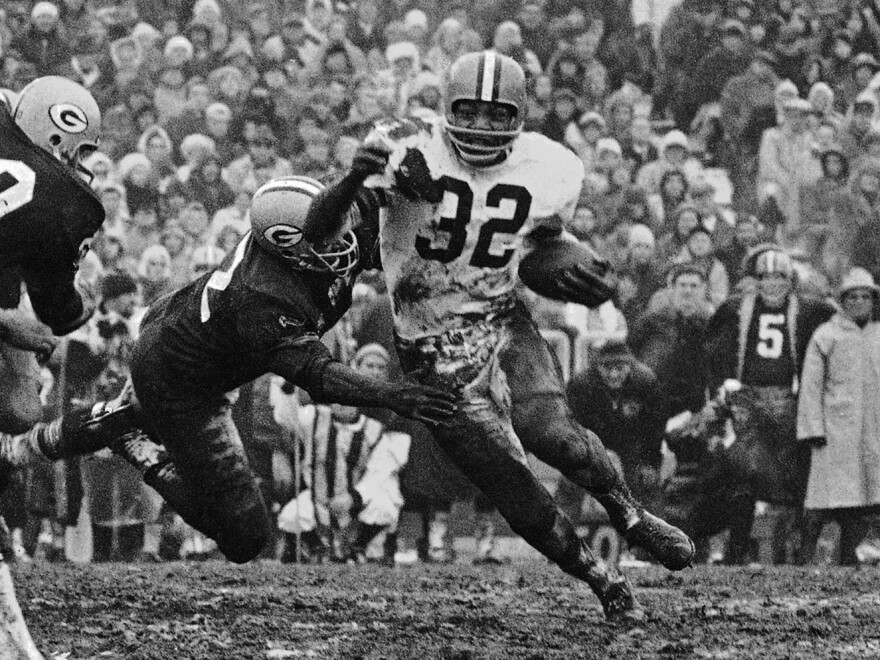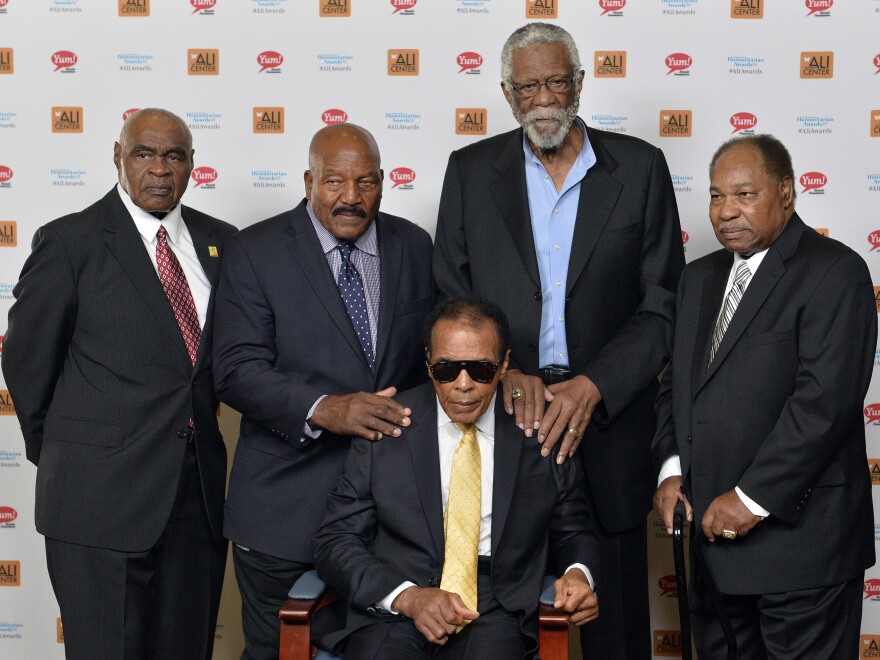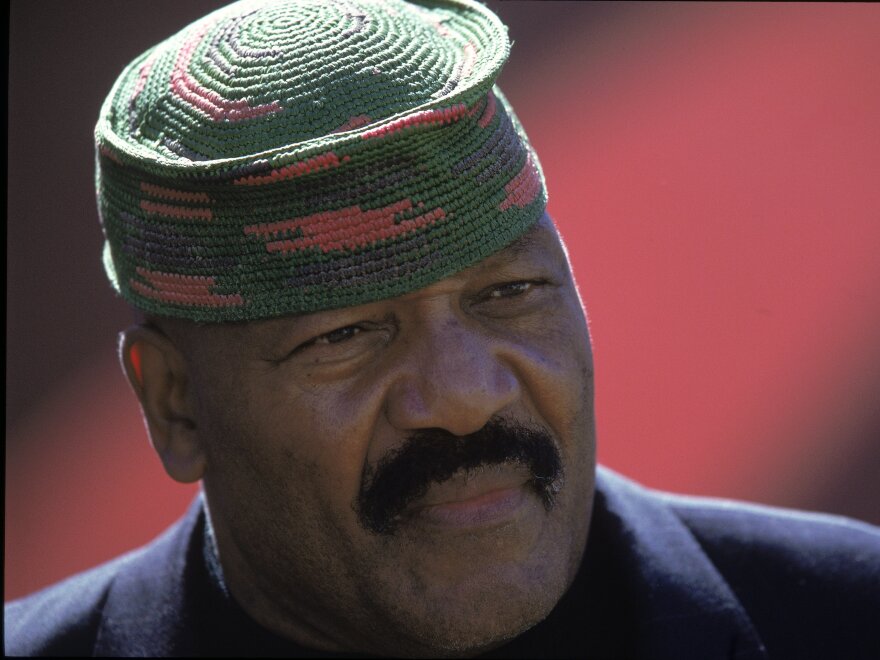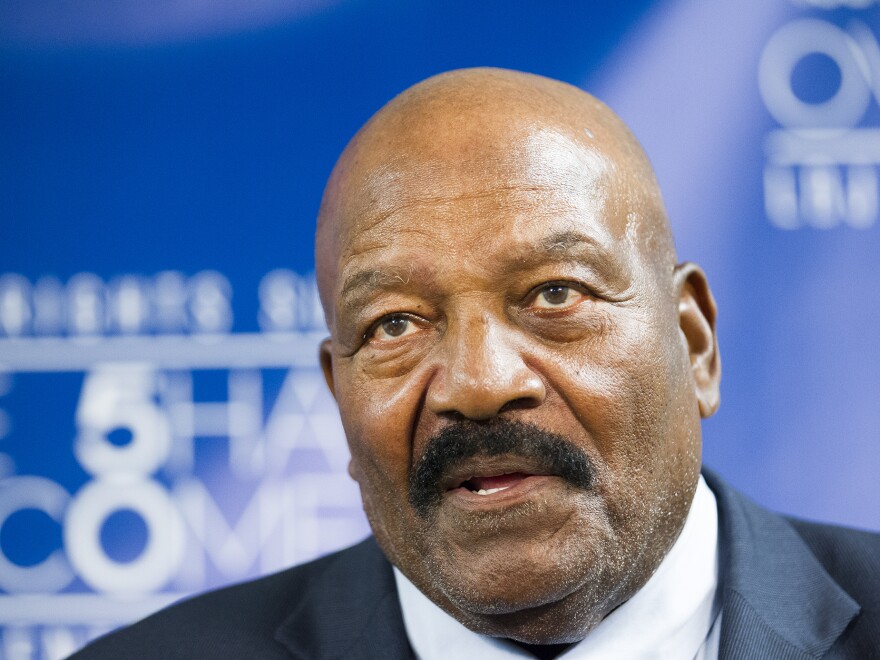Jim Brown, a blazingly fast running back and a star of the Cleveland Browns in the 1950s and 60s, has died. The Hall of Famer was 87. His wife, Monique Brown, announced that he "passed peacefully last night at our LA home."
"To the world he was an an activist, actor, and football star. To our family, he was a loving and wonderful husband, father, and grandfather. Our hearts are broken."
NFL Commissioner Roger Goodell called Brown a gifted athlete athlete and "one of the most dominant players to ever step on any athletic field." , he also singled out his involvement in the civil rights movement who became a forerunner and role model for athletes to become involved in social initiatives outside their sport.
In his nine seasons playing for the Cleveland Browns, Brown established himself as one of the sport's all-time greats. But football merely was the start of a life filled with accomplishment....and controversy.
A superb athlete
Jim Brown called it the most beautiful game he ever played. A blend of speed, quickness, intelligence. His abilities landed him in the Hall of Fame, the first Black player inducted.
For
It seemed incongruous, compared to his defining and violent sport of football. But it was a testament to Brown's – he competed in four sports at Syracuse University. Track and field, basketball, lacrosse and of course football.
That was the one that stuck.
He told the in 2000 he loved how football was a constant test.
"In every way," Brown said, "stamina-wise, mentally, courage. It pushes you to the brink and you can either deal with it or you can't."
Football fans agree, Jim Brown "dealt with it" perhaps better than any running back in the game's history.
Not just running through
There are defensive men in the league who have dedicated themselves, their souls and their bodies, to a holy war against Jimmy Brown. None of them yet has won the crusade.
With his chiseled six-foot-two-inch, 230-pound body, Brown sneered at the idea of running out of bounds on a play.
But his rare combination of power and speed and quickness meant he didn't only run through tacklers. He zipped around them and away from them, evidenced by the long touchdown runs that fill his .

Rushing for 100 yards in a game still is a gold standard for running backs. Brown averaged more than a hundred yards for each regular season game of his career.
He's the only one to do that in NFL history.
Other significant Jim Brown career numbers: 5.2 – average yards per carry; 8 – how many times he led the league in rushing during his 9 years; and 0 – the number of games he missed.
Was he the perfect running back? Almost. One hole in his resume was that he didn't like to block.
"The only thing I could say about Jim Brown," the late Hall of Fame defensive end Gino Marchetti said, "is that he might not have been the best blocker in the world. But who cares about that when you could run and do the things that he could do?"
Those things included Brown's mental approach to the game.
After being tackled, Brown always got up slowly. So defenders never knew, was he hurt, or not?
"[It was] a little bit of playing possum," said William Rhoden, a long-time sports columnist for the New York Times. "This is it, he's had it, and he'd slowly get up and then on the next play, would totally vanquish the defense."
Long before he wrote about Jim Brown, Rhoden loved watching him play as a young NFL fan. But he particularly loved , for good.
A proud man gets tough
It was the summer of 1966. Brown was 30, still in his playing prime. The previous year he'd won his third Associated Press, NFL MVP award. Brown also was an aspiring movie actor, and that summer he was in England shooting the World War II film, "The Dirty Dozen."
When production was delayed, it meant Brown would be late to Cleveland for training camp.
Team owner Art Modell decided to get tough with his star, and said Brown would be fined for days he missed.
So Brown got tough back. He .
A few days before his announcement, on the movie set, he sent Modell a letter.
"I was very sorry to see you make the statements that you did," Brown wrote, "because it was not a victory for you or I but for the newspaper men. Fortunately, I seem to have a little more faith in you than you have in me. I honestly like you and will be willing to help you in any way I can, but I feel you must realize that both of us are men and that my manhood is just as important to me as yours is to you."
Rhoden, who's African American, loved the defiant message Brown was giving to his team's owner.
"You're going to try to do that to me, this proud Black man? Screw you!" Rhoden said, "and that to me, is when his legend began to grow. And it would only increase after that."
A year after Brown's sudden retirement, he confirmed his growing legend by organizing what became known as the Cleveland Summit.

Athlete activists
Several top Black athletes of the era, including basketball stars Bill Russell and Lew Alcindor, who later changed his name to Kareem Abdul-Jabbar, joined Brown in a gathering to discuss the situation involving boxing champ Muhammad Ali.
Months before, Ali was stripped of his heavyweight title and faced charges for in the Vietnam War.
The athletes gathered in Cleveland to debate Ali's stance. But reportedly there was for their meetings. Brown and others potentially had a financial stake in Ali – there was a plan for Ali to fight exhibition matches for U.S. troops and have his charges dropped in exchange.
But Ali said no to the matches.
Still, Brown and the others rallied behind him in a show of unity. And the summit became an important moment in the history of athlete activism.
Brown would be a big part of that activism the rest of his life.
A different tack
But Jim Brown took a different tack.
He didn't believe in the power of marching and protest. In a , Brown said he admired civil rights leader Martin Luther King, Jr.'s courage and sincerity. But he disagreed with King's strategy of passive resistance.
"I didn't think that non-violence was a solution to the problem of inequality in America," Brown said. "So I thought economic development, and a sense of cultural power, would be a better way to fight. Because capitalism in America was riding high, and you need resources."

In 1988, Brown started a foundation called . Its mission was to stop gang violence that was tearing apart inner city communities in southern California, his home, and to give young Black people tools to reach those goals of economic development and cultural power.
Brown's house became the scene of peaceful gang meetings between the notorious Crips and Bloods. Anti-death penalty activist Aqeela Sherrills went to some of the meetings and embraced Brown's Amer-I-Can message.
"[Brown] said, you give me an opportunity to show you a different way of going about doing business, a different way of living your life," Sherrills said, "and I promise you--you will never have to worry about sustaining yourself economically, taking care of your families and taking care of your community for the rest of your life."
There was, in Jim Brown's life however, a troubling irony.
Holding him accountable
Brown effectively preached to others about empowerment and personal responsibility. But he appeared to ignore those ideals in with women.
Between 1965 and 1999, Brown was accused, tried and even jailed once, for multiple incidents of sexual and physical assault. These included the infamous 1968 fight in Hollywood between Brown and a young female model that prompted neighbors to call the police. When officers arrived, they found the woman lying dazed and injured under a balcony. Brown claims she fell trying to evade police; others say Brown threw her. He was charged with attempted murder but the woman decided not to pursue the case. Decades later, she told filmmaker Spike Lee, doing a documentary on Brown, that the football legend in fact pushed her off the balcony.
Through the years Brown would accept some responsibility, but largely would blame the public's perception of these incidents on what he called inaccurate media accounts.
"A lot has to do with things I've done," Brown said, "a lot has to do with things I've been accused of. But most of it has to do [with] the reporting of those things."
Writing in , sports journalist Dave Zirin said "not one conviction of violence against women emerged from any of the [charges against Brown]. Yet in almost all of these cases, Brown was not vindicated by a jury as much as by the women in question, who in nearly every instance refused to bring charges after initially calling the police."

Zirin writes at length about the many factors at play when delving into this part of Jim Brown's life – sex, politics, racism, power – all against the backdrop of a society that long ignored and even enabled violence against women.
Brown would acknowledge he had anger problems but chafed and often scoffed at the idea that he was a serial abuser of women.
Yet, the more than 30 years of cases against him are "a remarkable stretch that cannot be written off as just an endless series of law-and-order conspiracies, coincidences, or bad luck," Zirin wrote.
"Brown and others have seen these as politically motivated attacks attempting to tear down a strong Black man. Even without convictions of violence against women, there are enough 911 tapes and testimonials to see that this is not a fantasy created by those trying to destroy him."
For Rhoden, this part of Jim Brown's history was "more than a blemish. It's basically a blight," he said, "on an otherwise spectacular career."
And it was another lesson learned.
"Admire the political stuff, admire [Brown's] work with gangs," Rhoden said, "but also realize you had to hold him accountable for this other part."
A 2006 of Jim Brown was titled "The Fierce Life of an American Hero." Taking the full measure of Brown leaves one nodding at the idea of a fierce life – fierce, often triumphant, often meaningful.
But the hero part? Perhaps not.
Copyright 2023 NPR. To see more, visit https://www.npr.org.








